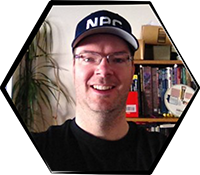Stephan Hornick
Community Goblin & Master of the Archive
Platinum WoA
Wizard of Story
Wizard of Combat
Borderland Explorer
Campaign Structure Part I
From Peter Maranci | updated May 20, 2021
Roleplaying Tips Newsletter #015
This is the first in a two-part series on campaign structure. Read Campaign Structure Part II.
Fundamental to any roleplaying campaign is the conceptual structure which controls it. That structure is the basic frame upon which the gamemaster creates the framework of the campaign, like a tapestry on a loom; as the initial pattern is set, so goes the game. And yet the creation of campaign structure is rarely considered as a subject in itself.
The basic building block of all plot structure is the story; a flow of events containing a beginning, a middle, and an end. This essential unit can be used in three ways. There are few unalloyed examples of these forms in the real world, of course; many stories combine different elements from various forms, with one type predominating.
The Stand-Alone: A to B to C
A stand-alone story is self-contained; the point of the story is the telling or playing of it, and once the end is reached there is nothing more to be said. In roleplaying, the one-shot scenario is an example of a stand-alone structure. Made-for-TV movies follow this pattern; so do many short stories. Anthology shows such as The Twilight Zone are an excellent example of collections of unrelated stand-alone plots.
This structure offers the advantage of extreme clarity and comparatively little commitment of time. It is limited in effectiveness, however. Compared to other, longer forms it doesn’t give the creator enough time to develop sub-themes and character development. Participants have less time to build a strong attachment to characters. On the other hand, a series of unconnected stand-alones allows treatment of many widely differing stories and settings.
A Never-Ending Cycle : A, B, C, A, B, C, A, B, C… (repeat until failure)
Take a set of characters and produce a string of stories about them and you have a cyclical plot structure. This is the most common form on television; almost every drama and sitcom falls into this pattern. So do most comic books. Early roleplaying campaigns used this form almost exclusively, and I suspect that it is still the most popular type of campaign.
The advantages of this form are several. In a way, it provides the greatest quantity of material for the effort expended by the creator; once the characters and setting are created, new stories may be plugged into the formula with ease. Characters and setting are unlikely to change, and so require little or no upkeep. The formula can be repeated indefinitely; participants will have a chance to become familiar with the characters and develop attachments.
Individual characters and settings can be more richly developed over time, as they accrue incidental details — though the creator(s) must be careful not to alter the basic structure, lest the cycle be disrupted and disaffect participants/consumers.
The cyclical form offers advantages from a sociological/economic perspective, too. As the only form which has the potential to continue indefinitely, it is ideally suited to a medium such as television in which the ultimate point is marketing. Obviously once a successful structure has been developed those who profit by it are unwilling to allow it to end…
…which is itself a disadvantage, of course. In television in particular the purpose of the cyclical story is not to tell a story, but to protect a profit-making entity. Thus a disadvantage of the cyclical form is its inherently static quality. Successors to the original Star Trek series are an excellent example of this; corporate executives have made no secret of the fact that their only purpose in producing the show is to “protect the franchise” and thereby their profits.
Absolute changelessness is the law. Thus far this approach seems to have been successful from a financial viewpoint, though it is arguable that the Star Trek story and universe have been diminished by it.
One interesting aspect of the cyclical story pattern is the means by which it ends. The point of such a pattern is to continue indefinitely; as with all things, however, the story eventually must come to an end. Since there is no provision for winding the cycle up, however, the result is that cyclical stories often end abruptly, with little or no sense of closure.
In the case of television, this means either no ending at all or a hasty wrap-up episode with no meaningful connection to the preceding body of work.
This is the first in a two-part series on campaign structure. Read Campaign Structure Part II.
Last edited:

